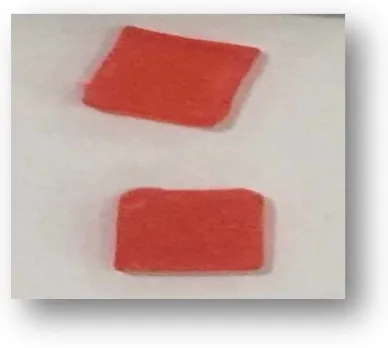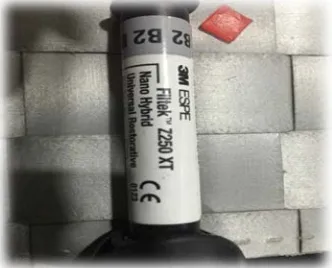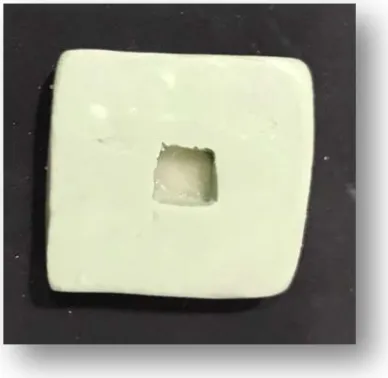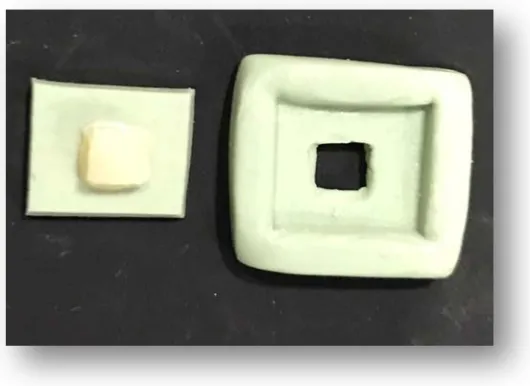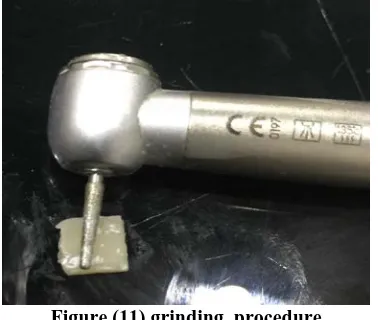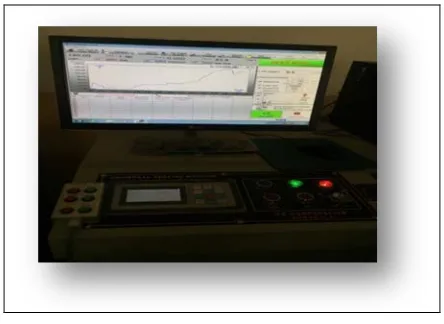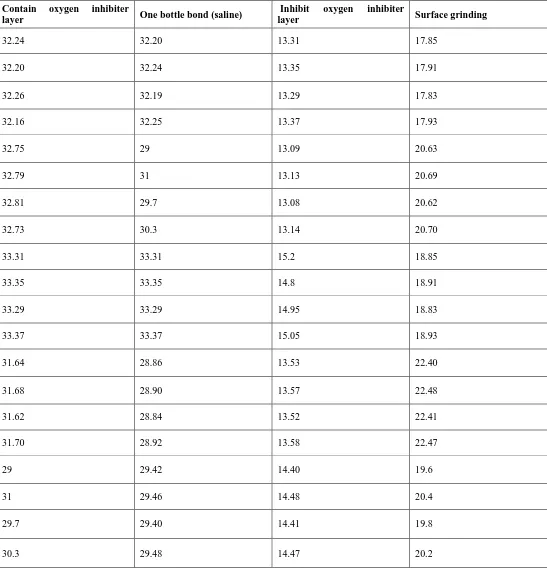Evaluation the Effect of Different Surface Treatment on
Shear Bond Strength between Composite Increments
(An in vitro study)
Zuha Ayad Jabber
Master of conservative dentistry, Collage of dentistry / university of kufa
Abstract- Objective: to evaluation the effect of different surface treatment on shear bond strength between composite increments to determine the most effective procedure that increase bond strength between composite increments Methods: four groups used in this study and each group consist of 20 blocks of composite, The block made at the same dimension: (3mm, 3mm, 2 mm) made from 3M Nano Hybrid Z 250XT.1st group: include Oxygen polymerization inhibited samples. 2nd group: include sample that inhibit the formation of Oxygen polymerization inhibited layer by utilize strip.3rd group: include the samples that uses3M one bottle self etch bond that contain silane . 4th group: include surface grinding of first composite increment by turbine diamond bur, each of these four groups composite from 20 block of composite . Using VALO Cordless curing light for composite increment curing. Results: the mean of bond strength for first group is 32.14 ± 1.148 Mpa , second group 30.75 ± 1.854 Mpa, third group 13.73 ± 1.301 Mpa and last group 19.67 ± 1.919 Mpa. The one way ANOVA (F-test) utilized to identify the significant differences between the four groups , L.S.D was apply to compare the differences of two groups as multiple comparison. The higher shear bond strength in group cotain oxygen inhibiter layer and group use one bottle bond (saline) group,and lowest mean result of group that Inhibit oxygen inhibiter layer formation and surface grinding groups. Conclusions: the shear bond strength between composite increment increase when there is oxygen inhibiter layer on the composite surface and also increase when used one bottle bond agent contain silane while the absence of oxygen inhibiter layer lower the bond strength between the increment when add another composite layer. also the rough surface gave better bond strength result compared to smooth surface.
Index Terms- Evaluation, effect, bond strength, composite increments
I. INTRODUCTION
he progressive using of composite restoration for anterior and posterior teeth has increased severely .at this time the a application of composite restoration are either by the increment technique or bulk fill . The basis for using increment layering technique are: 1- Layering procedure are extensively documented as a major reason in the diminution the stress of polymerization shrinkage.
2- The matching of the color for composite restoration with the natural color of the tooth obligate using a multiple composite shade that was helps in layering placement techniques to get an best color match for the normal tooth.
3- For all types of cavity classes with conservative cavity preparation make tooth colored restoration is ideal option (Roulet et al., 2001). 4- The majority of hybrid composites can just be cured to a depth of 2 mm, and for this reason layering procedure are necessary to fill
the cavity.
The layering procedure decrease C-factor of the configuration of the cavity and the failure of bonding to cavity wall following polymerization shrinkage. The highly possibility of porosity formation between the layers and the longer time taken by placing the increament make that as disadvantage. The dental restorative cosmetic work need be rapidly and simply bond to composite material .
(Irfan Ahmad, 2013)
In this paper studying the composite-to-composite union by using layer technique of two composite increments to recognize causes influencing the composite-to-composite bond and evaluate the effect inhibiter layer by oxygen and the lack of inhibiter layer. the oxygen reaction with free radical carbon-based to create peroxy radicals ,which is less reaction to dual bonds, the effectiveness of beginning of reaction is reduced, leading to significant delay of the polymerization . These unwanted reactions with oxygen take place at the layer facing air where the oxygen concentration is about 10-2 to 10-3 M .This cause the polymerization reaction delayed at the area directly facing air. (Andrzejewska, 2001)
The second group study the using of the 3M universal bond (one bottle technique),this system represent the seven generation in bond classification which characterize by join acid etch, prime, and bond agent in one bottle ,this system first introduce in 2002. The ‘conventional’ dentine adhesives systems apply acid etch or bonding agent or prime separately which all this must be done before insertion the filling material in to the cavity , this multiple steps increase the possibility for contamination by blood or saliva which have unfavorable outcome on the restoration bonding. (Abdalla Aet.al, 1998)( Asmussen E et.al,2001)( Sano H et.al 1998). To defeat this challenges ,many manufacture reach to collect the bond , etch and prime in one bottle to be apply in one step procedure and this will reduce the possibility of failure of bonding procedure . (MF Burrow, MJ Tyas 2003)
Silane agent are coupling agent which composed of bifunctional particle,one of these particle react with different kinds of inorganic material ex: glass and silica. at the same time as the other molecule react to several kinds of organic materials which increase the cause for using silane agent in composite defect or fracture repair (Sattabanasuk V, et.al 2004)
Also the effect of surface roughness on composite repair was study by utilize a diamond type bur to make the superficial facing layer of the composite coarse before place the second increment layer ,where the last group in this study the using colloid strip to cover first layer of composite during curing to avoid the construction of the polymerization inhibition layer .
II. MATERIALS AND METHODS
In this paper the comparison done between 4 group each group twenty block of composite which standardized to as the same dimension which is the length is 3mm, the width is 3mm, and block thickness is 2mm,each blocks construct according to group creation procedure condition.
Mold creation:
Starting by preparing block of sticky type wax at which is the length is 3mm, the width is 3mm, and block thickness is 2mm which show in figure one.
Figure (1) sticky type wax block
The dimension of the block of sticky type wax measured by digital vernier (total TMT322001) which shown in figure two to fit the dimension which is the length is 3mm, the width is 3mm, and block thickness is 2mm
[image:2.612.180.374.261.435.2] [image:2.612.110.510.510.710.2]This block of wax positioned on the table and by using a heavy body impression material,c-silicone impression material made first mold surrounding the block of wax which appear infigure three. After the final set of the heavy body material the block of wax was removed and now the mold is complete to use in production initial layer of composite blocks.
Figure (3) the block of wax surrounded by heavy body impression material
The first mold that construct of heavy body is bordered by layer of heavy body material to create another mold of a heavy body that are larger than first mold and the first constructed mold fit in it and have the same dimension represented by opening in the center to create the second composite layer of a composite block which is appropriate fit to first created layer of composite show in figure four.
Figure (4) the heavy body molds constructed for block of composite
The composite utilize in this study was 3 M Nano Hybrid Z250XT and the shade that selected was B2 which shown in figure five. Ash number 6 utilized for the applying the first layer of the composite into the costructed mold which appear in figure six.
[image:3.612.190.424.99.277.2] [image:3.612.248.448.365.505.2] [image:3.612.204.370.580.714.2]Figure (6) applying composite material using Ash number 6
The VALO Cordless curing light was used in this study which has many wavelength range from 395 to 480nm for 10 Sec. which used to made total set of first layer of composite block that prepared according to group production procedure .
The groups now are divide according to preparation procedure into:
The First group: which is contain Oxygen inhibited polymerization layer samples which is 20 block of composite are constructed by placing the first layer of composite in the heavy body mold, then using ash number 6 to adapted composite surface without put anything on the surface of blocks of the composite before curing for 10 Sec shown in figure seven. Then, the next layer composite apply and cured for 10 Sec in figure eight.
[image:4.612.286.452.77.220.2] [image:4.612.209.403.352.541.2]Figure (8) The first and second layer of composite layer
The second group: in this group prevent the formtion of Oxygen –polymerization inhibited layer this group compose of specimens 20 blocks of composite which are prepared by put the first layer in the costracted mold, then composite adapted by ash 6 after that the celluloid strip placed on the surface of composite block before doing curing for 10 Sec which appear in figure nine .
Then the second composite layer applies and cured for 10 Sec.
Figure (9) prevent the Oxygen –polymerization inhibited layer specimens
[image:5.612.174.439.91.284.2]Figure (10) a-bond Appling on composite layer b- 3M self etch
The four group: in which roughening outer surface of composite specimens done (20 blocks): in this group blocks are prepared by placing the first composite layer in the heavy body mold, then adapted by ash 6 then no strip was used. After curing the outer surface of the cured composite is grinned by using turbine diamond fissure bur which shown in figure (11) to produce rough outer surface of each specimen for 10s at highly speed with water spray cooling shown in figure (11) . Then, a second composite layer applied and cure for ten Seconds.
Figure (11) grinding procedure
The light used in curing is Light Emitting Diode (LED) Cordless VALO curing device shown in figure 12 with different wavelength rangs from 395 to480nm which give high intensity power for composite layer polymerization. The composite 3M cure at 400 to 500nm wave length, in which time need 10 sec to produce completcure.
Figure (12) VALO Cordless device
After complet preparing of the blocks ,do calculation for the force of union of the two increments of composite, because incremental techniques are identify as a main factor in the decrease of shrinkage stresses.
[image:6.612.118.488.57.214.2] [image:6.612.213.402.290.450.2] [image:6.612.195.545.511.631.2]Figure (13) completely cured four groups of composite block
The test of Shear bond strength :
Each one of the samples include 2 composite increments which is union together was placed and secured by tighten the prasser which close to a base of acrylic that the composite block embedded in it, in the Universal testing machine fixed part, with a ppling load cell of 5N, while the other composite side of block aligned with the upper testing machine movable compartment load axis .
Figure (14)A- specimen in machine. B- testing machine
The tensile force with shear load put on at the crosshead which at speed of 0.5 mm/min using the test machine appear in figure 14. sequentially to create a shearing force that produce the debonding of 2 composite increments by the slow speed of the crosshead was applied . The load produce the debonding was show in Newton and the data recorded by using computer software which presented in figure (15). To produce the bond strength in MPa the load cause the failure in Newton was divide by the block bond area in mm2. The results were collect, put into a tables then statistically analyzed.
[image:7.612.195.417.514.676.2]III. RESULTS
The result of measuring shear bond strength of each sample of the four study groups show in the table (1):
Surface grinding Inhibit oxygen inhibiter
layer One bottle bond (saline)
Contain oxygen inhibiter layer 17.85 13.31 32.20 32.24 17.91 13.35 32.24 32.20 17.83 13.29 32.19 32.26 17.93 13.37 32.25 32.16 20.63 13.09 29 32.75 20.69 13.13 31 32.79 20.62 13.08 29.7 32.81 20.70 13.14 30.3 32.73 18.85 15.2 33.31 33.31 18.91 14.8 33.35 33.35 18.83 14.95 33.29 33.29 18.93 15.05 33.37 33.37 22.40 13.53 28.86 31.64 22.48 13.57 28.90 31.68 22.41 13.52 28.84 31.62 22.47 13.58 28.92 31.70 19.6 14.40 29.42 29 20.4 14.48 29.46 31 19.8 14.41 29.40 29.7 20.2 14.47 29.48 30.3 Table (1)
[image:8.612.34.581.96.665.2]Table (2)
Methods Mean ±SD Sig. L.S.D
Contain oxygen inhibiter layer 32.14±1.148
0.000 1.811
One bottle bond (saline) 30.75±1.854
Inhibit oxygen inhibiter layer 13.73±1.301a,b
Surface grinding 19.67±1.919a,b,c
a= differ significantly (P<0.01) from group contain oxygen inhibiter layer, b= differ significantly (P<0.01) from One bottle bond (saline) group, c= differ significantly (P<0.01) from Inhibit oxygen inhibiter layer group.
• The mean result of Inhibit oxygen inhibiter layer group (strip placement ) was highly significant difference from group contain oxygen inhibiter layer and from One bottle bond (saline) group.
• The mean result of surface grinding group has a highly significant difference from mean results of the other groups.
• The mean result of oxygen inhibiter layer has non significant difference from mean results of One bottle bond (saline) group.
• The mean result of surface grinding group has non significant difference from mean results of One bottle bond (saline) group.
IV. DISCUSSION
The result that show highest mean among the study group was the group contain oxygen inhibiter layer (direct) which is 32.14 Mpa, which mean the two composite layers bonding of this group occur when polymerrization of material occur by radical polymerization which is complete in the existence of an oxygen inhibited layer with un-polymerized resin, the unwanted reactions in the presence of oxygen will result in strengthen the bond between the two composite increments .
Li J. found that fresh layer of composite which is enclosed by an oxygen inhibiter layer simply able to bond , because the presence of uncured surface layer, so the covalent bond is create with the recently applied layer of composite (Li J,1997).
The mean result of One bottle bond (saline) group was 30.75 Mpa that represent the second maximum results in the study groups because the existence of silane in 3M one bottle bond and the silane has union promoters effect because it composed of 2 reactive functional groups, that react with organic and inorganic materials.
Hisamatsu et al, in 2002 conclude that no matter what variation in the material, the mixing of a silane primer with bonding agent usually demonstrated the greatest degree of bond strength.
No significant difference detected between group contain oxygen inhibiter layer and One bottle bond (saline) group as both of them has highest bond strength result between 2 composite increments .
The lowest result of shear bond strength the 2 groups are surface grinding sample 19.67 Mpa and Inhibit oxygen inhibiter layer sample (strip group ) is 13.73 Mpa , which have significant difference from highest mean result (oxygen inhibiter layer group and One bottle bond group).
Tabatabaei et al, in 2004 found that to do repair of an aged restoration of composite material the best result obtain by surface treatment with diamond bur and silane.
[image:9.612.88.525.75.319.2](Mpa),which may be related to exposure of composite resin filler particles to disc (Yesilyurt C, et.al 2009) while utilize strip result in smooth sample surface which diminish mechanical micro-retention also may be due to absence of the oxygen inhibiter layer.
V. CONCLUSION
The samples that contain oxygen-inhibited layer on their outer surface show highest bond strength to newly add composite increment , which is adverse to the result of composite increment that covered by colloid strip before cure which show least bond strength.
The bond that contain silane coupling agent will raise the bond strength between composite increment, also surface roughness of composite surface raise bond strength between composite increment better than composite smooth surface.
The best suggested technique in application of composite was layering increment ) technique , during work the dentist may require using the celluloid strip or surface correction of composite by bur so the application of bond that contain silane necessary if we need additional composite increment .
REFERENCES
[1] Roulet, J.F., Wilson, N.H.F., Fuzzi, M. 2001. Advances in Operative Dentistry. Volume Contemporary clinical practice. Quintessence Publishing Co Inc. [2] Andrzejewska E. Photopolymerization kinetics of multifunctional monomers. Progr Polym Sci 2001;26:605-665.
[3] Abdalla AI, Davidson CL. Bonding efficiency and interfacial morphology of one-bottle adhesives to contaminated dentin surfaces. Am J Dent 1998;11:281-285. [4] Asmussen E, Peutzfeldt A. The influence of relative humidity on the effect of dentin bonding systems. J Adhes Dent 2001;3:123127.
[5] Sano H, Kanemura N, Burrow MF, Inai N, Yamada T, Tagami J. Effect of operator variability on dentin adhesion: students vs dentists. Dent Mater J 1998;17:51-58.
[6] MF Burrow,* MJ Tyas Clinical evaluation of an ‘all-in-one’ bonding system to noncarious cervical lesions — results at one year Australian Dental Journal 2003;48:(3):180-182
[7] Irfan Ahmad. Deep resins, white fillings: A new technique for composite restorations cosmetic dentistry 1_2013:13
[8] Sattabanasuk V, Shimada Y, Tagami J. The bond of resin to different dentin surface characteristics. Oper dent. 2004; (29)3:333─341. [9] Li J. Effects of surface properties on bond strength between layers of newly cured dental composites. J Oral Rehabil 1997; 24: 358-360.
[10] Yesilyurt C, Kusgoz A, Bayram M, Ulker M. Initial repair bond strength of a nano-filled hybrid resin: Effect of surface treatments and bonding agents. J Esthet Restor Dent. 2009;21:251–60.
AUTHORS
